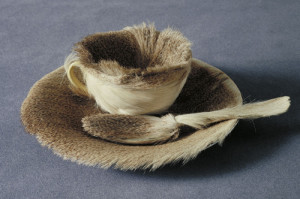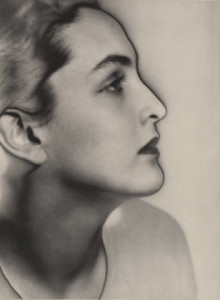The concept for Méret Oppenheim‘s most famous sculpture, Object (Luncheon in Fur), was born in a conversation with Pablo Picasso at a Paris café.
As Rebecca Mead tells it in the March 23rd issue of The New Yorker:
In 1936, Meret Oppenheim, the Swiss Surrealist artist, had tea with Pablo Picasso at the Café de Flore, in Paris. Oppenheim was wearing a bracelet, of her own design, that was clad in ocelot fur. Picasso admired it, noting that one could cover anything with fur. Soon afterward, Oppenheim produced her most famous work: a teacup, saucer, and spoon covered with the creamy-tan fur of a Chinese gazelle. The piece is now in the collection of the Museum of Modern Art, in New York, and is celebrated for its suggestive conjunction of the domestic and the erotic.
After Picasso’s casual observation, Oppenheim, who was just finishing her tea, reportedly joked “even this cup and saucer.” As the idea took hold, she turned and called out, to the amusement of all, “Waiter, a little more fur!”
Object is rich in sexual connotations, its back story in art world connections. Also seated at the table during the conversation was the photographer, Dora Maar — she and Picasso were then lovers. Maar posed for some of the most intense paintings Picasso ever made. Oppenheim herself had posed for their friend, the photographer Man Ray.
The unforgettable sculpture came to life when André Breton, the leader of the French Surrealists, asked Oppenheim to exhibit something in their next exhibition in Paris. Oppenheim went to a local department store to purchase the cup and saucer and the marriage of fur and teacup was consummated. It was Breton who came up with the name “Luncheon in Fur” (Déjeuner en fourrure), as a reference to Édouard Manet’s famously scandalous painting of 1863. The imaginative bracelet that caught Picasso’s eye was later bought from the struggling, young artist for a few Swiss francs by the Italian designer Elsa Schiaparelli.
Object was later exhibited at the Museum of Modern Art in New York, which purchased it in 1946. Its fame has only grown since then.
If all the talk of the eroticism of Object eludes you, simply imagine drinking hot liquid from the furry cup.


